Content for TS 38.305 Word version: 18.3.0
1…
4…
5…
6…
6.5…
6.7…
7…
7.3A…
7.4…
7.6…
7.11…
7.12…
8…
8.1.2.1a…
8.1.3…
8.2…
8.3…
8.4…
8.5…
8.6…
8.7…
8.8…
8.9…
8.10…
8.11…
8.12…
8.13…
8.14…
8.15…
A…
7 General NG-RAN UE Positioning procedures
7.1 General LPP procedures for UE Positioning
7.1.1 LPP procedures
7.1.2 Positioning procedures
7.1.2.1 Capability transfer
7.1.2.2 Assistance data transfer
7.1.2.3 Location information transfer
7.1.2.4 Multiple transactions
7.1.2.5 Sequence of procedures
7.1.2.6 Error handling
7.1.2.7 Abort
7.1.3 UE positioning measurements in RRC_IDLE state for NB-IoT
7.2 General NRPPa Procedures for UE Positioning
7.2.1 NRPPa procedures
7.2.2 NRPPa transaction types
7.2.2.1 Location information transfer
7.3 Service Layer Support using combined LPP and NRPPa Procedures
7.3.1 General
7.3.2 NI-LR and MT-LR Service Support
7.3.3 MO-LR Service Support
7.3.4 Deferred MT-LR Event Reporting Support
...
...
7 General NG-RAN UE Positioning procedures p. 44
7.1 General LPP procedures for UE Positioning p. 44
7.1.1 LPP procedures p. 44
Positioning procedures in the NG-RAN are modelled as transactions of the LPP protocol using the procedures defined in this specification. A procedure consists of a single operation of one of the following types:
- Exchange of positioning capabilities;
- Transfer of assistance data;
- Transfer of location information (positioning measurements and/or position estimate);
- Error handling;
- Abort.
7.1.2 Positioning procedures p. 44
7.1.2.1 Capability transfer p. 44
The capability transfer procedure between a "target" and a "server" is specified in clause 7.1.2.1 of TS 36.305.
7.1.2.2 Assistance data transfer p. 44
The assistance data transfer procedure between a "target" and a "server" is specified in clause 7.1.2.2 of TS 36.305.
7.1.2.3 Location information transfer p. 44
The location information transfer procedure between a "target" and a "server" is specified in clause 7.1.2.3 of TS 36.305.
7.1.2.4 Multiple transactions p. 44
Multiple LPP transactions may be in progress simultaneously as specified in clause 7.1.2.4 of TS 36.305.
7.1.2.5 Sequence of procedures p. 44
LPP procedures are not required to occur in any fixed order, in order to provide greater flexibility in positioning. Thus, a UE may request assistance data at any time in order to comply with a previous request for location measurements from the LMF; an LMF may instigate more than one request for location information (e.g., measurements or a location estimate) in case location results from a previous request were not adequate for the requested QoS; and the target device may transfer capability information to the server at any time if not already performed.
Despite the flexibility allowed by LPP, it is expected that procedures will normally occur in the following order:
- Capability Transfer;
- Assistance Data Transfer;
- Location Information Transfer (measurements and/or location estimate).
7.1.2.6 Error handling p. 45
The error handling procedure is specified in clause 7.1.2.6 of TS 36.305.
7.1.2.7 Abort p. 45
The abort procedure is specified in clause 7.1.2.7 of TS 36.305.
7.1.3 UE positioning measurements in RRC_IDLE state for NB-IoT |R16| p. 45
NB-IoT UEs may perform measurements for some positioning methods only when in RRC_IDLE state.
Figure 7.1.3-1 shows the general positioning procedure where the UE performs positioning measurements in RRC_IDLE state.
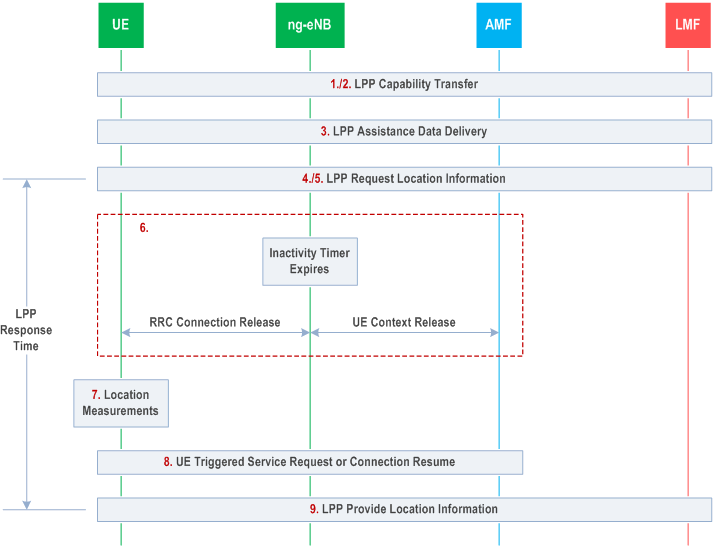
Step 1.
The LMF is aware of the UE access type and/or coverage level if applicable from the Location Service Request message received from the AMF. The LMF may send a LPP Request Capabilities message to the UE to obtain the UE positioning method capabilities from the UE, as described in clause 7.1.2.1.
Step 2.
The UE sends its positioning method capabilities to the LMF in a LPP Provide Capabilities message, including an indication of position methods for which the UE needs to make measurements in RRC_IDLE state.
Step 3.
The LMF may determine the assistance data required for the selected position method or methods, and sends them in one or more LPP Provide Assistance data messages to the UE, as described in clause 7.1.2.2. If an LPP acknowledgement was requested, the UE sends an LPP acknowledgment for each received LPP Provide Assistance data message to the LMF.
Step 4.
If the UE capabilities from step 2 indicate that RRC_IDLE state is required for positioning measurements, the LMF may allow additional response time to the UE to obtain the location measurements, and sends one or more LPP Request Location Information messages to the UE requesting positioning measurements or a location estimate, and including the required response time, as described in clause 7.1.2.3. For E-CID positioning method, when NRSRP/NRSRQ measurements are requested the UE is requested to provide NRSRP/NRSRQ measurements for intra-frequency neighbour cells and for inter-frequency neighbour cells. The UE may use inter-frequency information in system information of the serving cell specified in TS 36.331 to decide on which inter-frequency cells to measure.
Step 5.
The UE sends an LPP acknowledgement for each received LPP Request Location Information message to the LMF, if an LPP acknowledgement was requested at step 4 but does not perform the requested measurements.
Step 6.
The UE may finish any other activities in progress (e.g., SMS or data transfer), and waits until the network releases or suspends the connection (after a certain period of inactivity). The UE will then receive an RRC connection release or suspend from the ng-eNB due to the expiration of the inactivity timer.
Step 7.
When the UE has entered RRC_IDLE state, the UE performs the measurements requested in step 4.
Step 8.
Before the location measurements are to be sent to the LMF, the UE instigates a UE-triggered service request or, when User Plane CIoT 5GC optimization applies, the Connection Resume procedure as defined in TS 23.501, if the UE is not using Control Plane CIoT 5GC Optimisation, in order to establish a signalling connection with the AMF. If the UE is using Control Plane CIoT 5GC Optimisation, procedures for Mobile Originated Data Transport in Control Plane CIoT 5GC optimisation as defined in TS 23.501 are performed by the UE to establish a signalling connection with the AMF.
Step 9.
When the LPP response time received in step 4 expires (or when location measurements are available before expiry), the UE sends one or more LPP Provide Location Information messages containing the requested location measurements or location estimate obtained in step 7 to the LMF.
7.2 General NRPPa Procedures for UE Positioning p. 46
7.2.1 NRPPa procedures p. 46
Positioning and data acquisition transactions between a LMF and NG-RAN node are modelled by using procedures of the NRPPa protocol. There are two types of NRPPa procedures:
- UE associated procedure, i.e. transfer of information for a particular UE, including the procedures supporting the Positioning Information Transfer, E-CID Location Information Transfer and Measurement Preconfiguration Information Transfer functions;
- Non UE associated procedure, i.e. transfer of information applicable to the NG-RAN node and associated TRP, including the procedures supporting the OTDOA Information Transfer, Assistance Information Transfer, TRP Information Transfer, Measurement Information Transfer and PRS Information Transfer functions.
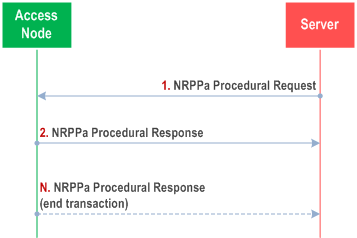
Figure 7.2.1-1 shows a single NRPPa transaction. The transaction is terminated in step 2 in procedures including OTDOA Information Exchange, TRP Information Exchange, PRS Configuration Exchange and Measurement Preconfiguration. For procedures such as Positioning Information Exchange, Measurement and E-CID Measurement Initiation, additional responses may be allowed (e.g. sending of updated information periodically and/or whenever there is some significant change). In this case, the transaction may be ended after some additional responses. In the NRPPa protocol, the described transaction may be realized by the execution of one procedure defined as a request and a response, followed by one or several procedures initiated by the NG-RAN node (each procedure defined as a single message) to realize the additional responses. The Correlation ID, as specified in TS 29.572, included by the LMF when it invokes the Namf_Communication_N1N2MessageTransfer AMF service operation to transfer the NRPPa PDU may be used by the LMF to identify the target UE positioning session.
7.2.2 NRPPa transaction types p. 47
7.2.2.1 Location information transfer p. 47
The term "location information" in this clause refers to the information used in, or used for assisting in, computing position (e.g., cell information, SRS configurations, radio measurements or positioning measurements). It is delivered in response to a request.
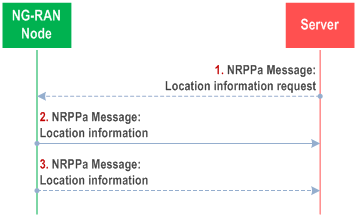
Step 1.
The server sends a request for location related information to the NG-RAN node, and indicates the type of location information needed. The request may refer to a particular UE.
Step 2.
In response to step 1, the NG-RAN Node transfers location related information to the server. The location related information transferred should match the location related information requested in step 1.
Step 3.
If requested in step 1, the NG-RAN node may transfer additional location related information to the server in one or more additional NRPPa messages.
7.3 Service Layer Support using combined LPP and NRPPa Procedures p. 47
7.3.1 General p. 47
As described in TS 23.502 and TS 23.273, UE-positioning-related services can be instigated from the 5GC for an NI-LR or MT-LR location service, or from the UE in case of an MO-LR location service. The complete sequence of operations in the 5GC is defined in TS 23.502 and TS 23.273. This clause defines the overall sequences of operations that occur in the LMF, NG-RAN and UE as a result of the 5GC operations.
7.3.2 NI-LR and MT-LR Service Support p. 47
Figure 7.3.2-1 shows the sequence of operations for an NI-LR or MT-LR location service, starting at the point where the AMF initiates the service in the LMF.
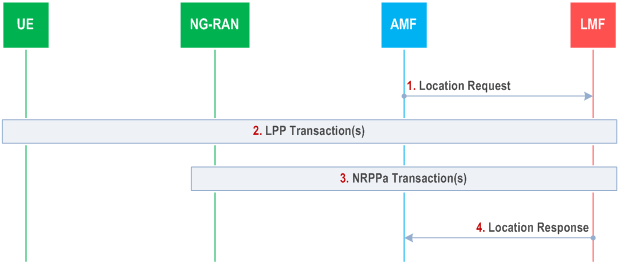
Step 1.
The AMF sends a location request to the LMF for a target UE and may include associated QoS, the scheduled location time and the UE LPP positioning capabilities when available, as described in TS 23.273.
Step 2.
The LMF may obtain location related information from the UE and/or from the serving NG-RAN Node. In the former case, the LMF instigates one or more LPP procedures to transfer UE positioning capabilities, provide assistance data to the UE and/or obtain location information from the UE. The UE may also instigate one or more LPP procedures after the first LPP message is received from the LMF (e.g., to request assistance data from the LMF). If a scheduled location time is provided in step 1, the LMF may schedule location measurements by the UE to occur at or near to the scheduled location time. The LPP procedures to transfer UE LPP positioning capabilities may be skipped if the LMF already obtained the UE positioning capabilities from the AMF in step 1.
Step 3.
If the LMF needs location related information for the UE from the NG-RAN, the LMF instigates one or more NRPPa procedures. Step 3 is not necessarily serialised with step 2; if the LMF and NG-RAN Node have the information to determine what procedures need to take place for the location service, step 3 could precede or overlap with step 2. If a scheduled location time is provided in step 1, the LMF may schedule location measurements by the NG-RAN to occur at or near to the scheduled location time.
Step 4.
The LMF returns a location response to the AMF with any location estimate obtained as a result of steps 2 and 3. The LMF may also return the LPP UE capabilities as described in TS 23.273.
7.3.3 MO-LR Service Support |R16| p. 48
Figure 7.3.3-1 shows the sequence of operations for an MO-LR service, starting at the point where an LCS Client in the UE or the user has requested some location service (e.g., retrieval of the UE's location or transfer of the UE's location to a third party or transfer of the Mobile TRP's location to LMF as specified in TS 23.273).
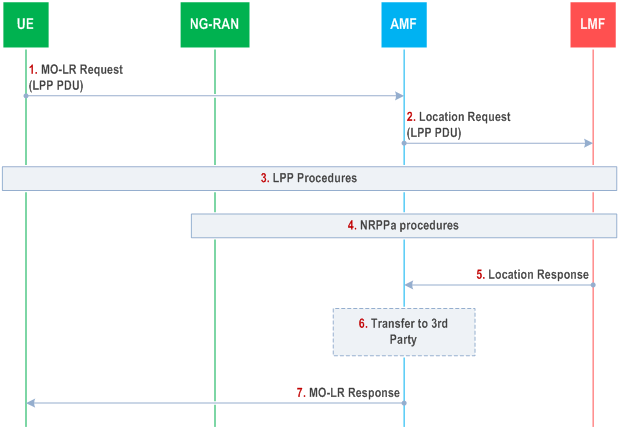
Step 1.
The UE sends an MO-LR location service request message included in a UL NAS TRANSPORT message as specified in TS 24.501 to the AMF. The MO-LR location service request message may carry an LPP PDU to instigate one or more LPP procedures to transfer capabilities, request assistance data, and/or transfer location information and the scheduled location time, as described in TS 23.273.
Step 2.
The AMF invokes the Nlmf Determine Location Request service operation towards the LMF as specified in TS 29.572 and includes any LPP PDU, the scheduled location time received in step 1 and the UE LPP positioning capabilities when available.
Step 3.
The LMF may obtain location related information from the UE and/or from the serving NG-RAN node. In the former case or if an immediate response is needed to any LPP procedure instigated by the UE in step 1 (e.g., a request for assistance data), the LMF instigates one or more LPP procedures to transfer UE positioning capabilities, provide assistance data to the UE and/or obtain location information from the UE. The UE may also instigate further LPP procedures after the first LPP message is received from the LMF (e.g., to request assistance data or to request further assistance data). If a scheduled location time is provided in step 2, the LMF may schedule location measurements by the UE to occur at or near to the scheduled location time. The LPP procedures to transfer UE positioning capabilities may be skipped if the LMF already obtained the UE positioning capabilities from the AMF in step 2.
Step 4.
If the LMF needs location related information for the UE from the NG-RAN, the LMF instigates one or more NRPPa procedures. Step 4 may also precede step 3 or occur in parallel with it. If a scheduled location time is provided in step 1, the LMF may schedule location measurements by the NG-RAN to occur at or near to the scheduled location time.
Step 5.
The LMF invokes the Nlmf Determine Location Response service operation towards the AMF as specified in TS 29.572 which includes any location estimate obtained as a result of steps 3 and 4. The LMF may also return the LPP UE capabilities as described in TS 23.273.
Step 6.
If the UE requested location transfer to a third party the AMF transfers the location received from the LMF in step 5 to the third party as defined in TS 23.273.
Step 7.
The AMF sends an MO-LR location service response message included in a DL NAS TRANSPORT message as specified in TS 24.501.
7.3.4 Deferred MT-LR Event Reporting Support |R16| p. 49
Figure 7.3.4-1 shows the sequence of operations for a Deferred MT-LR Event Reporting starting at the point where the UE reports an event to the LMF.
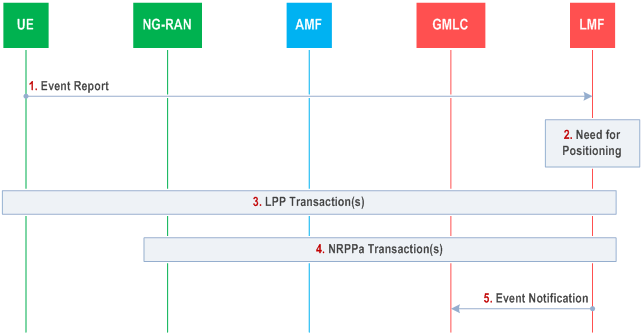
Step 1.
The UE sends a supplementary services event report message to the LMF as described in TS 24.571 which is transferred via the serving AMF and is delivered to the LMF using an Namf_Communication_N1MessageNotify service operation. The event report may indicate the type of event being reported and may include an embedded positioning message which includes any location measurements or location estimate, protection level and achievable target integrity risk.
Step 2.
If LMF determines no positioning procedure is needed, steps 3 and 4 are skipped.
Step 3.
The LMF may utilize any location information received in step 1. The LMF may also retrieve location related information from the UE and/or from the serving NG-RAN Node. In the former case, the LMF instigates one or more LPP procedures to provide assistance data to the UE and/or obtain location information from the UE. The UE may also instigate one or more LPP procedures after the first LPP message is received from the LMF (e.g., to request assistance data from the LMF).
Step 4.
If the LMF needs location related information for the UE from the NG-RAN, the LMF instigates one or more NRPPa procedures. Step 4 is not necessarily serialised with step 3; if the LMF and NG-RAN Node have the information to determine what procedures need to take place for the location service, step 43 could precede or overlap with step 3.
Step 5.
The LMF invokes an Nlmf_Location_EventNotify service operation towards the GMLC with an indication of the type of event being reported and any location estimate obtained as a result of steps 3 and 4.